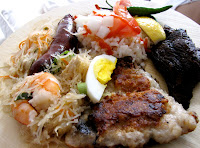
My love affair with profiteroles started almost 16 years ago (yikes!) when I first started working at I Tre Merli as a bartender. On the menu they had a dish called Bongo Bongo, which consisted of profiteroles filled with ice cream and topped with a warm chocolate sauce. The dish was simple, yet it was amazing, and for some reason I was never able to find it anywhere else. Every time I saw profiteroles on a menu I got excited and inevitably when I ordered the I was always disappointed because the pastry chef, however talented he may have been, overcomplicated the dish by adding weird fillings and sauces. For this reason, as usually happens when I cannot find a dish the exact way I want it, I decided to make it myself.
The first time I made profiteroles I was scared and did not think that I would be able to recreate those puffs of joy, but I can assure you that they are not hard to make. The nice thing about profiteroles is that they are versatile and never cease to impress. You will need to familiarize yourself with the use of a pastry bag, but this is a skill that you will be able to use time and time again. Once mastered you can make savory gougeres, a.k.a cheese profiteroles and other delectable treats.
Although you can cut the profiteroles in half and fill them with ice cream and top with chocolate sauce, the profiteroles in this recipe have been filled with pastry cream. The pastry cream is inspired from a dessert at Tabla, Chef Floyd Cardoz’ restaurant in Gramercy, which consisted of beignets with an orange blossom dipping sauce. The flavors at this restaurant are inspiring and you cannot help but think about how you can incorporate them into your next dish.
Pate a Choux
1 stick of butter
1 cup of water
1 tsp of sugar
½ tsp of salt
1 cup of flour
4-5 large eggs
In a heavy bottomed saucepan bring to a boil the butter, water, sugar and salt. Remove from the heat and add in the flour. Stir with a wooden spoon until incorporated and then return to the heat and cook for 3-4 minutes, while continuously stirring, until the dough starts to pull away from the sides of the pan and leaves a light residue on the bottom of the pan.
Remove from the heat and add the dough to a stand mixer with the beating attachment and beat on low speed for 2-3 minutes until slightly cool. On medium speed, one by one, add the eggs until fully incorporated. Beat for a minute on medium speed. When done the batter should create a string when the beater is lifted from the bowl. (See photo below). If the consistency is not right, beat the last egg with a little water and add a little at a time until you get the right consistency.
Transfer the mixture to a pastry bag with a pastry tip and pipe into little circles as in the photo below. Use your discretion with the size of the pastry tip you want to use. If I want to make larger pate a choux for a dinner party, I will use a larger tip, for larger groups, I will make smaller ones.
When filling my pastry bag I find it useful to place the bag in a large glass and pull the bag over the sides of the glass to stabilize before I fill. Otherwise everything goes all over the place and I get more of my filling on the floor then in the bag.
You can brush the pan with butter, but I find it easiest to use a Silpat (in my amazon.com store below).
After finished piping, flatten the tips (see below) with an egg-water wash. I usually use the leftover egg mixture that I added to thin the pate a choux batter.
In a preheated oven bake the profiteroles at 400 degrees for 20 minutes and then reduce to 350 and cook until the are golden brown. This usually takes another 10-15 minutes. Cool completely before you fill with the pastry cream.
Pastry Cream
2 cups milk
3 egg yolks
¼ cup honey
¼ sugar
pinch of salt
3 Tbs plus 1 tsp cornstarch
2 Tbs unsalted butter cut into pieces
2 tsp orange blossom flower water
1/3 cup heavy whipping cream
Heat milk, honey and salt to a simmer over medium heat and set aside. In a separate bowl beat the sugar, egg yolks and cornstarch one tablespoon at a time, fully incorporating each tablespoon before you add the next.
In a low stream add half of the milk to the egg mixture to temper. (Err on the side of caution when you first learn this technique and incorporate a little of the heated milk slowly or else your eggs will scramble.) Return the egg-milk mixture to the remaining milk and bring to a boil over medium-high heat while continuously whisking until the custard thickens.
Remove from the heat, whisk in the butter one piece at a time and then add the orange blossom water. Place in another bowl and line the surface with saran wrap so a skin doesn’t form. Chill in the refrigerator for at least a few hours.
When ready to assemble whip the heavy cream until soft peaks are formed and fold into the pastry cream to lighten. Fill a pastry bag with the mixture, as described above, and pipe through the bottom into the profiteroles. Top with powdered sugar.
You can find orange blossom water at most gourmet markets, Middle-Eastern stores, or in my store on amazon.com below.
For step, by step photos and more pastry arts techniques, check out http://www.joepastry.com/.














CMYK.jpg)






















